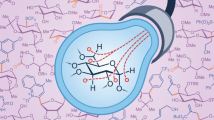Abstract
Molecular design, chemical synthesis, and biological evaluation of several organic molecules, which can target-selectively photodegrade oligosaccharides by irradiation with a specific wavelength of light under mild conditions without any additives, are introduced. These novel class of photochemical agents promise bright prospects for finding not only molecular-targeted bioprobes for understanding of the structure-activity relationships of oligosaccharides but also novel therapeutic drugs targeting biologically important oligosaccharides.










Similar content being viewed by others
References
Ernst, B., Hart, G.W., Sinaÿ, P. (eds.): Carbohydrate in Chemistry & Biology. Wiley, Weinheim (2000)
Kamerling, J.P., Boons, G.J., Lee, Y.C., Suzuki, A., Taniguchi, N., Voragen, A.G.J. (eds.): Comprehensive Glycoscience. Elsevier, Oxford (2007)
Ishii, M., Matsumura, S., Toshima, K.: Target-selective degradation of oligosaccharuides by a light-activated small-molecule lectin hybrid. Angew. Chem. Int. Ed. 46, 8396–8399 (2007)
Takahashi, D., Hirono, S., Hayashi, C., Igarashi, M., Nishimura, Y., Toshima, K.: Photodegradation of target oligosaccharides by light-activated small molecules. Angew. Chem. Int. Ed. 49, 10096–10100 (2010)
Nishibu, M., Takahashi, D., Toshima, K.: Carbohydrate recognition and photodegradation by an anthracene–Kemp’s acid hybrid. Org. Biomol. Chem. 10, 8393–8395 (2012)
Bycroft, B.W. (ed.): Dictionary of Antibiotics & Related Substances. Chapman & Hall, London (1988)
Koch, T., Ropp, J.D., Sligar, S.G., Schuster, G.B.: Photocleavage of DNA-irradiation of quinone-containing reagents converts supercoiled to linear DNA. Photochem. Photobiol. 58, 554–558 (1993)
Toshima, K., Maeda, Y., Ouchi, H., Asai, A., Matsumura, S.: Carbohydrate-mediated DNA photocleavage: Design, synthesis, and evaluation of novel glycosyl anthraquinones. Bioorg. Med. Chem. Lett. 10, 2163–2165 (2000)
Bender, M.L., Komiyama, M. (eds.): Cyclodextrin Chemistry. Springer, New York (1978)
Simkovic, I., Alfoldi, J.: Acetylation of (4-O-methyl-d-glucurono)-d-xylan under homogeneous conditions using trifluoroacetic acid-acetic anhydride. Carbohydr. Res. 201, 346–348 (1990)
Gibson, A.R., Melton, L.D., Slessor, K.N.: ω–Aldehydo sugars prepared by ninhydrin oxidation. Can. J. Chem. 52, 3095–3912 (1974)
Aquino, A.M., Abelt, C.J., Berger, K.L., Darragh, C.M., Kelley, S.E., Cossette, M.V.: Synthesis and photochemistry of some anthraquinone-substituted β-cyclodextrins. J. Am. Chem. Soc. 112, 5819–5824 (1990)
Lis, H., Sharon, N.: Lectins as cell recognition molecules. Science 246, 227–234 (1989)
Lotan, R., Skutelsky, E., Danon, D., Sharon, N.: The purification, composition, and specificity of the anti-T lectin from peanut (Arachis hypogaea). J. Biol. Chem. 250, 8518–8523 (1975)
Ravishankar, R., Ravindran, M., Suguna, K., Surolia, A., Vijayan, M.: Crystal structure of the peanut lectin-T-antigen complex. Carbohydrate specificity generated by water bridges. Curr. Sci. 72, 855–861 (1997)
Springer, G.F.: T and TN, general carcinoma Auto-antigens. Science 224, 1198–1206 (1984)
Hamachi, I., Nagase, T., Shinkai, S.: A general semisynthetic method for fluorescent saccharide-biosensors based on lectin. J. Am. Chem. Soc. 122, 12065–12066 (2000)
Daffe, M., Brennan, P.J., McNeil, M.: Predominant structural features of the cell wall arabinogalactan of Mycobacterium tuberculosis as revealed through characterization of oligoglycosyl alditol fragments by gas chromatography/mass spectrometry and by 1H and 13C NMR analyses. J. Biol. Chem. 265, 6734–6743 (1990)
Mikušová, K., Yagi, T., Stern, R., McNeil, M.R., Besra, G.S., Crick, D.C., Brennan, P.J.: Biosynthesis of the galactan component of the mycobacterial cell wall. J. Biol. Chem. 275, 33890–33897 (2000)
Scherman, M.S., Winans, K.A., Stern, R.J., Jones, V., Bertozzi, C.R., McNeil, M.R.: Drug targeting Mycobacterium tuberculosis cell wall synthesis: Development of a microtiter plate-based screen for UDP-galactopyranose mutase and identification of an inhibitor from a uridine-based library. Antimicrob. Agents Chemother. 47, 378–382 (2003)
Lorand, J.P., Edwards, J.O.: Polyol complexes and structure of the benzeneboronate ion. J. Org. Chem. 24, 769–774 (1959)
Springsteen, G., Wang, B.: A detailed examination of boronic acid-diol complexation. Tetrahedron 58, 5291–5300 (2002)
James, T.D.: Boronic acid-based receptors and sensors for saccharides. In: Hall, D.G. (ed.) Boronic Acids: Preparation, Applications in Organic Synthesis and Medicine, pp. 441–479. Wiley-VCH, Weinheim (2006)
Norrild, J.C., Eggert, H.: Evidence for mono- and bisdentate boronate complexes of glucose in the furanose form. Application of 1 J C-C coupling constants as a structural probe. J. Am. Chem. Soc. 117, 1479–1484 (1995)
Springsteen, G., Wang, B.: Alizarin Red S. as a general optical reporter for studying the binding of boronic acids with carbohydrates. Chem. Commun. 1608–1609 (2001)
Djanashvili, K., Frullano, L., Peters, J.A.: Molecular recognition of sialic acid end groups by phenylboronates. Chem. Eur. J. 11, 4010–4018 (2005)
Navarre, W.W., Schneewind, O.: Surface proteins of gram-positive bacteria and mechanisms of their targeting to the cell wall envelope. Microbiol. Mol. Biol. Rev. 63, 174–229 (1999)
Kemp, D.S., Petrakis, K.S.: Synthesis and conformational analysis of cis, cis-1,3,5-trimet hylcyclohexane-1,3,5-tricarboxylic acid. J. Org. Chem. 46, 5140–5143 (1981)
Askew, B., Ballester, P., Buhr, C., Jeong, K.S., Jones, S., Parris, K., Williams, K., Rebek Jr., J.: Molecular recognition with convergent functional groups. 6. Synthetic and structural studies with a model receptor for nucleic acid components. J. Am. Chem. Soc. 111, 1082–1090 (1989)
Williams, K., Askew, B., Ballester, P., Buhr, C., Jeong, K.S., Jones, S., Rebek Jr., J.: Molecular recognition with convergent functional groups. 7. Energetics of adenine binding with model receptors. J. Am. Chem. Soc. 111, 1090–1094 (1989)
Hayashi, N., Ujihara, T., Kohata, K.: Binding energy of tea catechin/caffeine complexes in water evaluated by titration experiments with 1H-NMR. Biosci. Biotechnol. Biochem. 68, 2512–2518 (2004)
Hirose, K.: A practical guide for the determination of binding constants. J. Incl. Phenom. Macrocycl. 39, 193–209 (2001)
Toshima, K., Hasegawa, M., Shimizu, J., Matsumura, S.: Molecular design, chemical synthesis, and biological evaluation of anthracene-carbohydrate hybrids as novel DNA photocleaving and photoselective cytotoxic agents. ARKIVOC 28–35 (2004)
Acknowledgments
The authors wish to sincerely thank all of the co-authors of the references cited in this review article. This research was supported in part by Scientific Research (B) (No. 23310153 and 26282212), Scientific Research on Innovative Areas “Chemical Biology of Natural Products” (No. 24102528 and 26102738), and Grants-in-Aid for Young Scientists (B) (No. 22710220) from the Ministry of Education, Culture, Sports, Science and Technology of Japan (MEXT).
Conflict of interest
The authors declare that they are free from conflict of interest.
Author information
Authors and Affiliations
Corresponding author
Rights and permissions
About this article
Cite this article
Toshima, K., Takahashi, D. Chemical approach for target-selective degradation of oligosaccharides using photoactivatable organic molecules. Glycoconj J 32, 475–482 (2015). https://doi.org/10.1007/s10719-015-9591-9
Received:
Revised:
Accepted:
Published:
Issue Date:
DOI: https://doi.org/10.1007/s10719-015-9591-9




